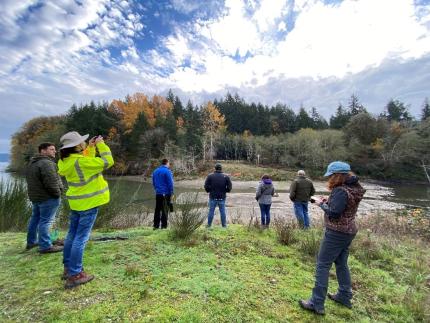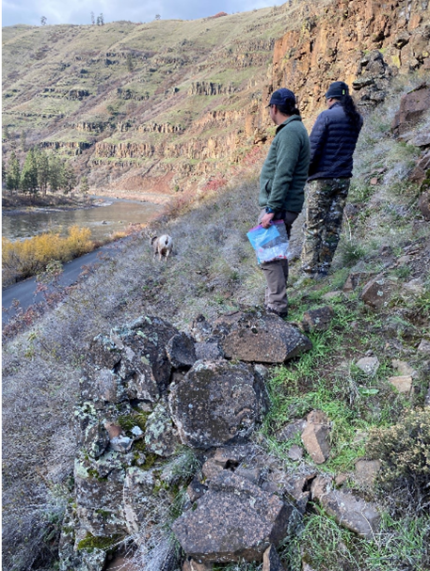
Wildlife Program report: Nov. 16-30, 2023
Providing Recreation Opportunities
Trail Inventory and Assessment: Planning and Recreation staff members are close to putting a statewide route inventory and conditions assessment contract up for bid to take place in 2024. Staff members are also gathering information from land managers to solidify a contract for cultural resource review of Quincy Lakes.
The contract with TREAD for trail conditions assessment in Quincy Lakes is coming to a close. TREAD sent over the final report and data from the project. One more meeting with our Science Division GIS team and TREAD should wrap up the project.
Methow Wildlife Area Planning: Lands staff members have been working with the Wildlife Program GIS team in the development of a habitat mapping tool that will be used for the recreation planning process. The team plans to introduce the tool to the Methow Wildlife Area Planning Team at the December meeting. This tool will be used to help identify sensitive areas for the recreation planning process.
Conserving Natural Landscapes
Skagit Wildlife Area Planning: The Skagit Wildlife Area planning team completed a goal and objective prioritization exercise. The planning team was split into five subgroups to rank a list of objectives under their respective goals. The goals and objectives were provided from the draft Wildlife Area Management Plan and were expected to go through State Environmental Policy Act (SEPA) study in early 2024. The subgroups consisted of species and habitats, waterfowl, salmon recovery, recreation, and operations & maintenance. The process was considered successful despite a few glitches with the system. Overall, it was well received by the planning team members.
Providing Education and Outreach
Ambassador Program: Staff members had the final debrief with Washington Trails Association on the Ambassador Program. Planning and Recreation staff members discussed strategy with Washington Department of Fish and Wildlife’s Communications and Public Engagement (CAPE) team on how CAPE can support the Ambassador Program in 2024 by highlighting the program in news releases.
The Region 4 listening sessions contract is currently up for bid and will close on Dec. 11. Planning and Recreation and CAPE staff members will review the proposals to decide on the winning bid.
Conducting Business Operations and Policy
Regional Water Access Management Planning: A working planning framework has been finalized and will remain in draft form as it is applied to the Region 4 planning pilot called for in the 10-year recreation strategy. Initial meetings have been held with the Region 4 core team and CAPE to begin initial preparations including messaging strategy, planning team development, and other organizational elements.
Managing Wildlife Populations
Bighorn Sheep: Biologists Wik and Vekasy spent the last two weeks capturing six-month-old bighorn lambs along the Grande Ronde River as part of a new monitoring effort. This effort has been assisted by the new Oregon Department of Fish and Wildlife District Biologist Wolf, the new Idaho Fish and Game Technician Scott, Confederated Tribes of the Umatilla Indian Reservation Wildlife Manager Wildbill, and Nez Perce Tribe Wildlife Manager Kash Kash. This collaborative effort has resulted in 20 bighorn lambs being captured and fitted with GPS collars. They hope to better understand how young animals are using the landscape. With healthy bighorns along the Grande Ronde exhibiting rapid population growth, the risk of dispersing animals is poorly understood.

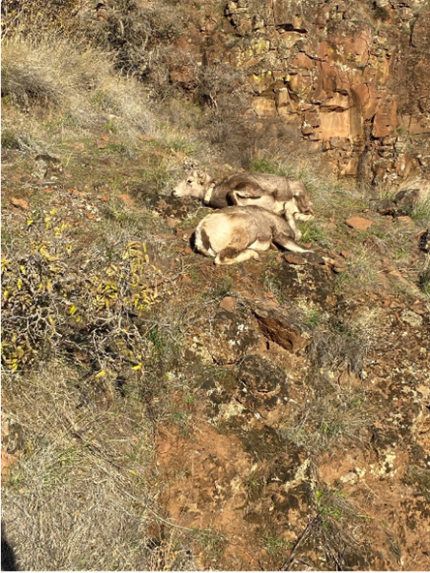
Grouse: Biologists Lowe and Brinkman attended the annual Sage and Sharp-tailed Grouse Workshop in Ellensburg. Washington Department of Fish and Wildlife staff members, partners from other agencies, universities, tribes, and non-government agencies participated in the meeting to discuss grouse populations statewide. There were presentations regarding the status of the birds on different properties, discussions about translocation efforts, and updates on solar and wind development projects that could impact habitat for grouse.
Chronic Wasting Disease (CWD): Wildlife Conflict Specialist Harris collected a CWD sample from a buck harvested in GMU 117.
Natural Resource Technician Heitstuman collected CWD samples from area Department of Transportation collection pits and relayed calls to other team members for pits in their areas. Roadkill opportunities are remaining constant.
Private Lands Biologist Nizer went to a hunter’s camp to take CWD samples from two deer, one white-tail buck and one mule deer doe.
Bighorn Sheep: Biologists Lowe and Brinkman completed an aerial survey of the Lincoln Cliffs bighorn sheep herd. Low fog delayed the start of the flight, but the weather eventually cleared enough to complete the survey. GPS locations of each observed group were recorded, and the biologists subsequently counted the total number of individuals in each group as well as the group composition (including the number of ewes, lambs, and different age classes of rams).
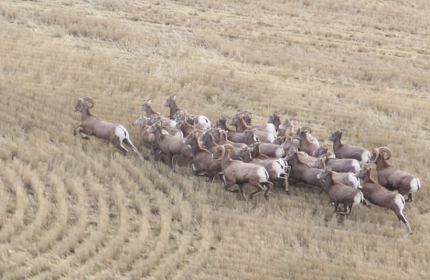
Columbia Basin Mule Deer: Biologists Lowe and Brinkman conducted six ground-based mule deer surveys in Lincoln and Whitman counties. Ground surveys were also conducted in Districts 4, 5, and 7. The surveys are used to estimate post-season herd composition including fawn to doe and buck to doe ratios for three subherds across the Columbia Basin. This year, aerial surveys are also being conducted for the Odessa subherd in parts of Lincoln and eastern Grant counties for population estimation. Biologist Brinkman and biologists from Districts 4 and 5 were able to fly three and a half days of surveys in between periods of heavy fog this week. Ground and aerial surveys will continue next week.
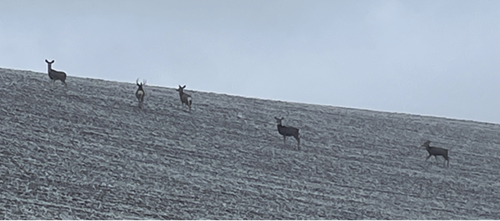

Providing Recreation Opportunities
Columbia Plateau Wildlife Management Association: Private Lands Biologist Nizer met with Columbia Plateau Wildlife Management Association President Lubey, past President Hinkle, and a new landowner to sign a contract for 1,000 acres in the Hunt by Written Permission Program. Nizer worked with District Wildlife Biologist Lowe to discuss additional tags that could be issued for the upcoming season because of the added acreage. Nizer also added the new property into the private lands hunting opportunities so that it will be available to the public on the agency hunt planner app.
Columbia Plateau Wildlife Management Association Incentive Tag: Private Lands Biologist Nizer spoke with the Columbia Plateau Wildlife Management Association about an additional incentive cow tag for landowners specifically joining the Hunt by Written Permission Program or to retain landowners in the program. Nizer worked with District Biologist Lowe to see if this would be feasible for the upcoming season setting.
Turnbull Meeting Preparation: Private Lands Biologist Nizer gathered statistics on the first turkey reservation season on the Turnbull Wildlife Refuge. Nizer also reached out to hunters that hunted the Long Lake reservation to determine their success rate. While not many harvested, a good number of them heard or saw turkeys in the area. Nizer will bring these statistics to his meeting with Turnbull Wildlife Manager Moroney next week. Nizer will be meeting to discuss additional hunt areas for the 2024 fall turkey season.
Providing Conflict Prevention and Education
Asotin Creek Wildlife Area – Weatherly Unit Elk Fence Repair: All Asotin Creek Wildlife Area staff members spent the majority of the week making repairs to the elk fence at Weatherly. Wind-fall trees, rotten posts, loose staples are a chronic problem. So far, staff members have spent two full work weeks on the fence beginning at Mountain Road. They have not finished repairs and anticipate it will take all the short week next week and the week after Thanksgiving to finish.
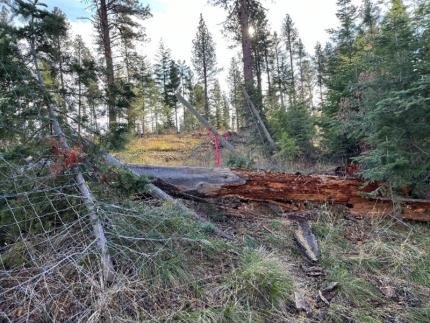
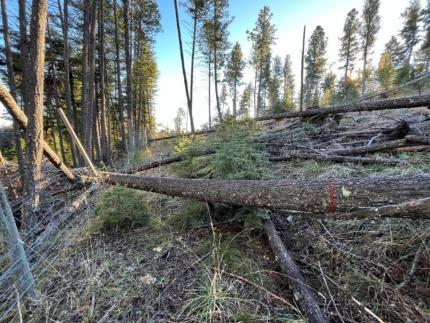
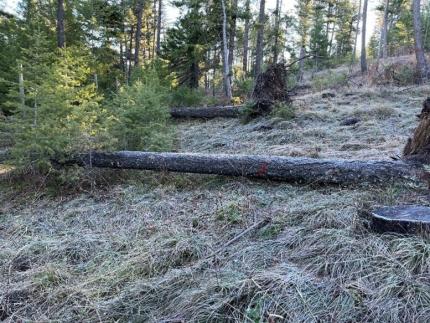
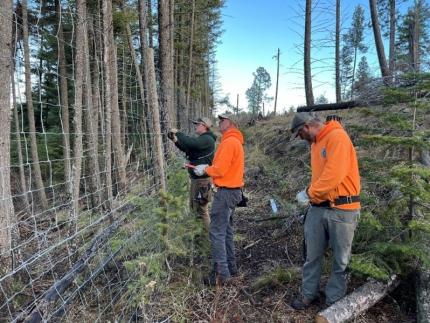
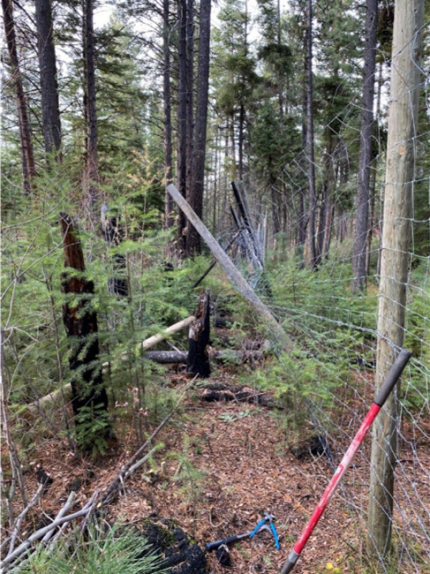
Depredation Investigation: Staff members investigated an injured steer calf which had grazed in Columbia County over the summer and fall. The determination of the investigation was unconfirmed because there was no clear evidence as to what caused the injury.
Staff members investigated four dead sheep and ten injured sheep in Columbia County. The determination of the investigation was a confirmed non-wild wolf depredation event by a domestic dog.
Asotin Creek Wildlife Area Weatherly Elk Fence Repairs: Wildlife area staff members continued making repairs to the elk fence on the Weatherly Unit. Most of the work this week involved repairing broken rock jacks and hammering in loose staples. Staff members have two miles of fence to go over and hope to complete repairs by the end of the month.

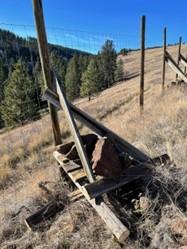
Producer Contacts: Wildlife Conflict Specialist Wade was in contact with a Grouse Flats producer this week to discuss the producers lower than normal return rate. The producer also reported that he believed that many of his cows were not breed when they shouldn’t have been. Wade recommended that the producer explore filing an indirect loss claim and put the producer in touch with Statewide Wildlife Conflict Analyst Todd.
Cougar Depredation: Wildlife Conflict Specialist Harris investigated a dead goat that was reported to have been killed over the weekend. Based on evidence found on scene and sightings reported by the landowner, Harris determined that the goat had been killed by a cougar. Harris coordinated with Stevens County Sheriff's Office and a Washington Department of Fish and Wildlife contracted hound hunter to deploy a cell camera. The cougar did not return the next night and the landowner removed the goat carcass for disposal.
Forest Management: Sherman Creek Wildlife Area Assistant Manager Palmer, Natural Resource Specialist Zueger, and Access Manager Dziekan removed undesirable lodgepole pines at the West Branch parcel of LeClerc Creek Wildlife Area on Thursday. This work followed a test run the previous week. The trio used Sherman Creek Wildlife Area’s new Echo brand pole-style tools with brush-cutter blades. Lodgepole pine seedlings and saplings were cut, leaving tree species that should be on the site. Leave trees included primarily ponderosa pine, Douglas fir, and western larch, along with some Engelmann spruce and western white pine. With the three staff members working one day plus Palmer putting in a couple hours earlier in the week, they cleaned up about 20 acres of land.
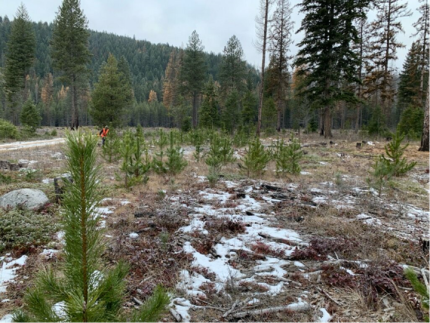


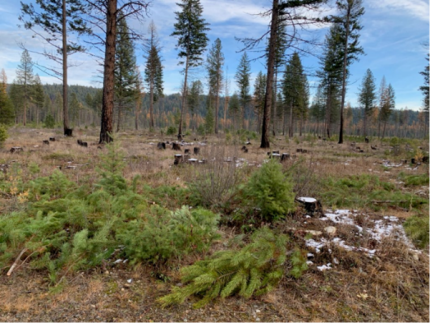
Conserving Natural Landscapes
Swegle Unit – Noxious Weed Control: Natural Resource Technicians Tritt and Jensen met Maintenance Mechanic Heimgartner and Access Technician Nielsen at the Swegle Unit of the W.T. Wooten Wildlife Area. They worked on mowing kochia and Russian thistle skeletons, piling them, and hauling them to the landfill in the dump trailer. A total of four loads were hauled this week, making a grand total of 13 loads of kochia and Russian thistle skeletons hauled to the landfill so far this fall. Jensen sprayed the cheatgrass in Stovall Field while they were on the site.
Conservation Reserve Enhancement Program Seeding: Private Lands Biologist Nizer reached out to a local producer who is enrolled in the Conservation Reserve Enhancement Program (CREP) and seeded about two acres of native grass seed mix. The stand should stay dormant for the winter, and with good moisture they should sprout up in the spring. Nizer used the Tye no-till drill. The drill was the perfect size for the smaller project.
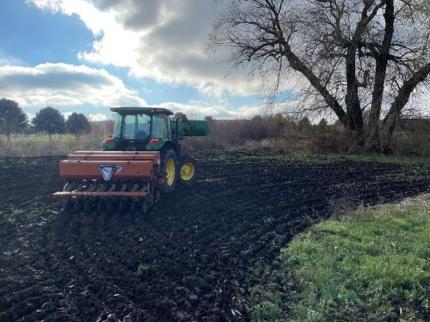
Spring Plantings: Wildlife Conflict Specialist Harris met with the Stevens County Conservation District to discuss plans for a riparian restoration project at the Vetter Farm. Harris put in an order for trees and shrubs to be planted next spring.
Habitat Plantings: Private Lands Biologist Hadley planted shrubs on two Feel Free to Hunt properties located in Walla Walla County. Hadley contacted the local Pheasants Forever chapter habitat chairman to discuss volunteer opportunities to assist. Hadley also coordinated with the Pheasants Forever biologist in Ephrata to meet and work with her.
Revere Wildlife Area Wetland Enhancement Project: Wildlife Area Manager Finch was able to meet Washington Department of Fish and Wildlife Archeologist Davis at the Revere Wildlife Area wetland project site. Phase 3 of the project was funded through a North America Wetlands Conservation Act and Ducks Unlimited grant. The purpose of the grant is to scrape off the heavy infestation of bulrush and to get more open water. Finch was able to explain the project to Archeologist Davis and fly the drone over the area to get some aerial photos.
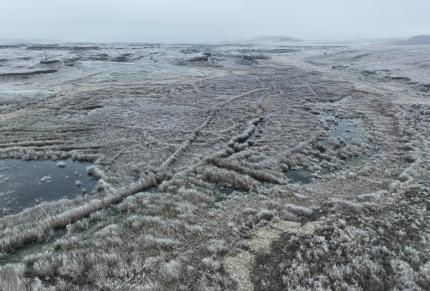
Asotin Creek/Chief Joseph Winter Gate Closures: Wildlife area staff members began closing winter closure gates just before midnight on Thursday. Wildlife Area Manager Dice closed the Asotin Creek Wildlife Area gates on Lick Fork and South Fork roads. He also closed U.S. Forest Service gates at the top of Smoothing Iron and Pinkham Butte. The gate at the top of Lick Creek was already shut by Forest Service staff members. Woodall closed the ATV access gate at Green Gulch on Thursday and attempted to close the winter gate on Cougar Creek Road. He did not close Cougar Creek due to someone having a camp in the Autry Campground and another vehicle parked near one of our gates. There is a late muzzleloader deer season in progress in Unit 172.
Providing Education and Outreach
Appreciation: Wildlife Conflict Specialist Kolb and Region 1 Hunter Education and Volunteer Coordinator Dazey presented a plaque of appreciation to the Waitsburg Gun Club board members during their monthly meeting. The Waitsburg Gun Club goes above and beyond sponsoring and supporting youth activities, including Washington Department of Fish and Wildlife hunter education field day evolutions.
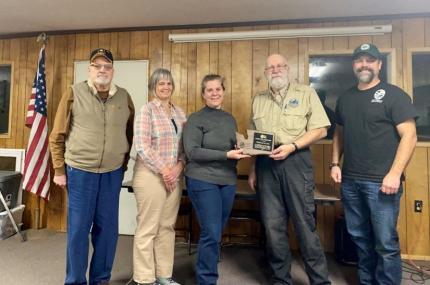
Access Area Kiosks: Washington Department of Fish and Wildlife (WDFW) has been working on a project to install more kiosks and entrance signs on WDFW lands throughout the state. Region 1 installations will begin the next year or two, and detailed planning has started. Access Area Manager Dziekan reviewed the sites, identifying which access areas would benefit from having a single pane vs. a triple pane kiosk. Dziekan will begin submitting requests in the next several weeks for cultural review, well ahead of the planned installation work to prevent delays.
Volunteer Coordination: Wildlife Conflict Specialist Kolb finalized the volunteer schedule for a Washington State University student to participate over their winter holiday break.
Turkey Damage Outreach: Private Lands Biologist Nizer worked with Communication Consultant Lehman to create an article about turkey damage in Spokane County. The article will discuss how hunters can help farmers reduce the damage done to private lands. The article will let hunters know about the access program for turkey hunting and inform landowners that might be interested in joining the program.
University of Idaho Student Mentoring: Wildlife Area Manager Dice spent Tuesday afternoon with two sophomore University of Idaho students majoring in Wildlife Resources. The students accompanied Dice on several tasks at the wildlife area which gave them an opportunity to observe and ask questions. Dice and Woodall each agreed to serve as mentors for two students earlier this fall as part of an outreach class taught by University of Idaho. Many other natural resource professionals are serving in the same role for this class. Most are employees from Idaho Fish & Game.
Conducting Business Operations and Policy
Private Lands Statewide Budget: Wildlife Conflict Supervisor, Private Lands Access Manager McClellan, Landowner Services Division Manager Yarborough, and Wildlife Program Budget Analyst Quinton met and went through the Private Lands statewide budget.
Managing Wildlife Populations
Deer Management: Biologists Dougherty and Clements have completed their aerial surveys for Game Management Unit (GMU) 290 and are now gearing up to conduct additional aerial surveys along areas of the Columbia Plateau. Biologists surveyed 40 units in GMU 290 and observed over 380 deer across the units.

Annual Deer Surveys: Private Lands Biologist Braaten assisted District 7 staff members with annual deer surveys in Douglas County. Private Lands Biologist classified 149 mule deer (95 does, 31 fawns, and 23 bucks). Biologist Morris conducted deer ground surveys in Adams and Grant counties to classify deer by age and sex. The district biologist will use these surveys to develop hunting recommendations for future hunting seasons in the area.
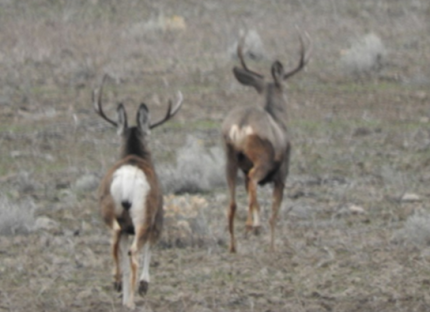
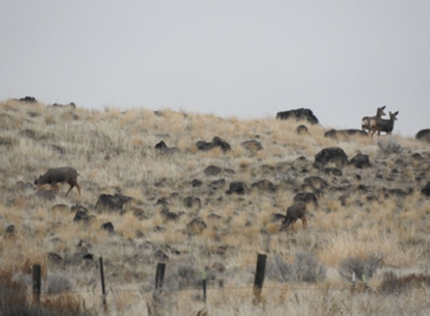
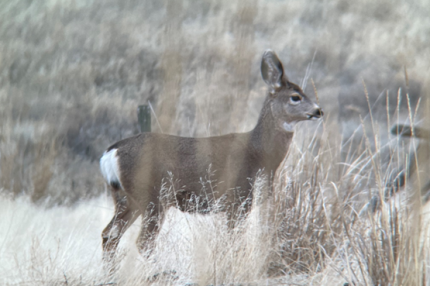
Pygmy Rabbit Drone Surveys: The team continues to test the best drone survey method for pygmy rabbit burrows. Adjusting the height and speed of the drone makes a great impact on the clarity of the images. Other considerations include image overlap, camera angle, wind speed, and weather conditions.
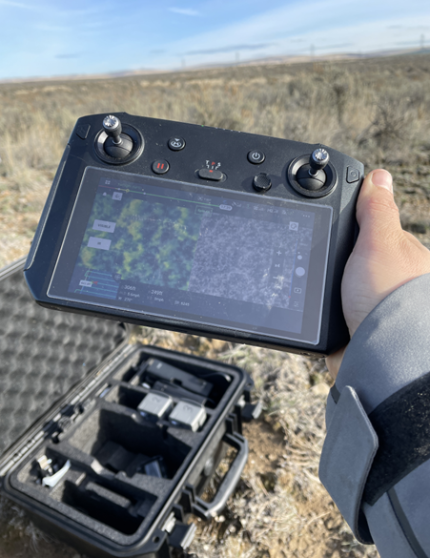
Rimrock Wild Population Pygmy Rabbit Monitoring: For the last two weeks, the Passive Integrated Transponders (PIT) monitoring system has been moved around the Rimrock Meadows wild population area. The array was set up between active burrow systems in hopes of obtaining individual identifications. Much to the dismay of the biologists, no rabbits were detected via the PIT tag monitoring system. Cameras were set up in the vicinity the system to observe if there were pygmy rabbits in the area that were simply un-tagged. The cameras showed only cottontails, confirming that the PIT tag monitoring system was functioning and had not missed any pygmy rabbits.
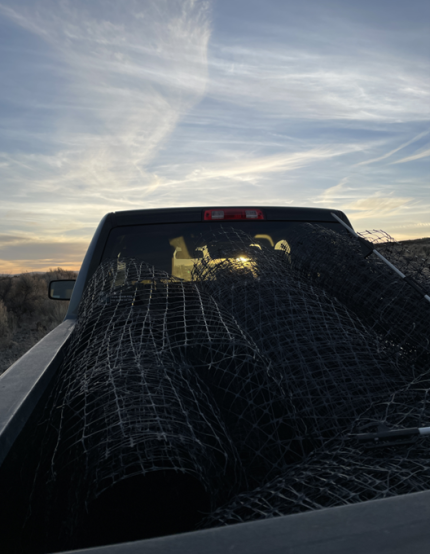
Pygmy Rabbit Rimrock Breeding Enclosure: The raptor netting was completely extracted from the Rimrock enclosure before winter conditions hit the region. These large 8-foot by 30-foot nets were deployed within the enclosure to provide extra protection from raptors, including hawks and owls. In times without snow, these nets are perfectly safe for rabbits. However, in extreme snowfall these nets could collapse onto the ground and potentially entangle a rabbit.
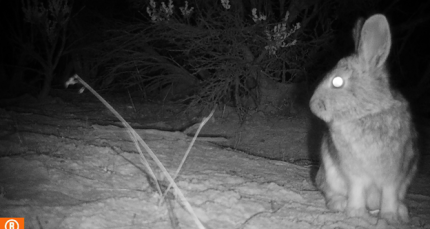
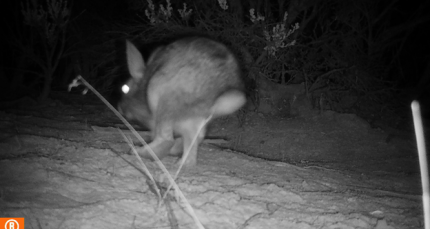
Conserving Natural Landscapes
Native Tree and Shrub Planting: Private Lands Biologist Braaten and Region 2 Private Lands staff members, landowners, and volunteers worked to complete a Private Lands Riparian Habitat Project in Douglas County. The landowner was awarded Natural Resource Conservation Service awards with technical and financial assistance from their Environmental Quality Incentives Program. The landowner had a long working relationship with Washington Department of Fish and Wildlife (WDFW) over many years. He reached out for assistance and WDFW Private Lands staff members assisted to complete the project in three days. Two thousand trees and shrubs were planted in mulch fabric.
Habitat Plots: Biologist Morris sprayed weeds in a habitat plot so that hopefully next year the weeds will be controlled, and he will be able to continue planting native shrubs, grasses, and forbs to benefit wildlife.
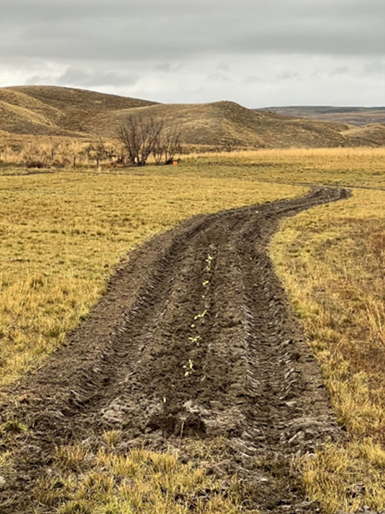
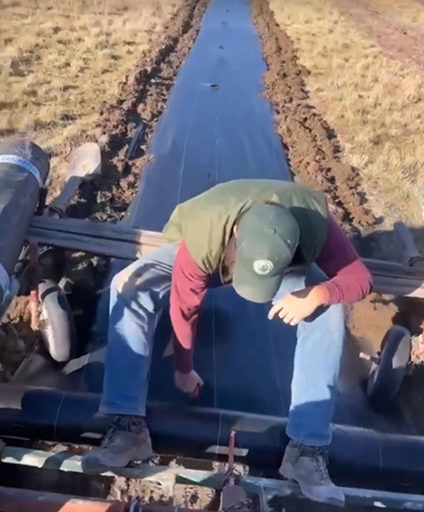
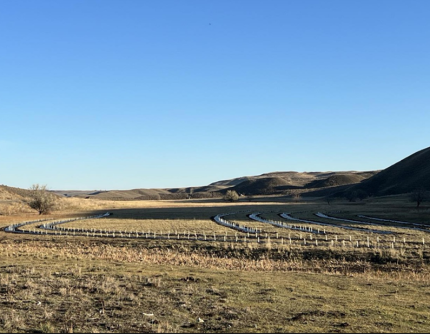
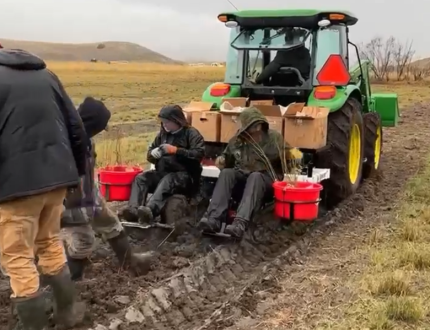
Fall Riparian Habitat Planting: Private Lands Biologist Braaten was able to get some more fall hand planting done in Douglas County before snow and freezing temperatures returned. Sixty red osier dogwoods, 30 elderberry, and 20 service berries were planted.
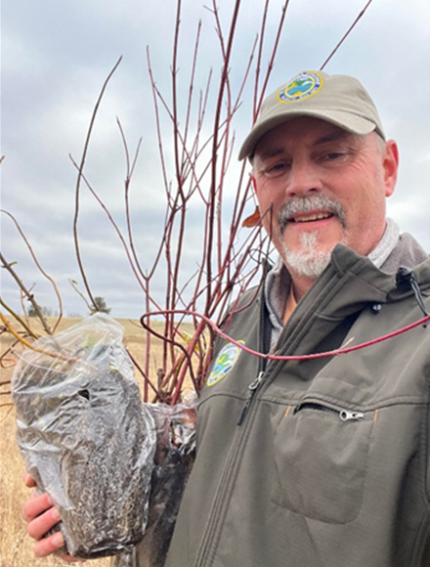
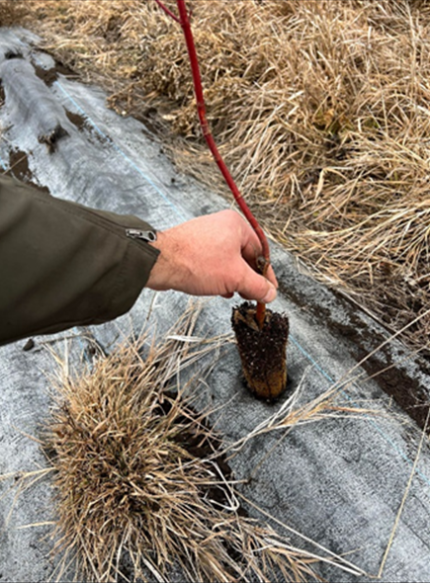
Pygmy Rabbits Release Pen Removal: The 2022 Palisade release pens have been removed from the field and are back in storage until release efforts resume. Even with near frozen ground, the Washington Conservation Corp, based out of Wenatchee, did an excellent job prying these fences out and rolling them up for removal.
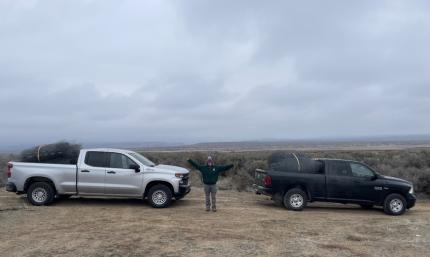
Conducting Business Operations and Policy
Columbia Basin Pygmy Rabbit Working Group: The first Columbian Basin Pygmy Rabbit Working Group meeting, hosted and led by Biologist Husband of the U.S. Fish and Wildlife Service, took place on Nov. 28. This group brings multiple partners together for the recovery of the Columbian Basin pygmy rabbit. While not a decision-making body, this provides a working space for brainstorming and sharing ideas regarding the recovery of the Columbian Basin pygmy rabbit. Twenty-nine people from seven different agencies attended.
Managing Wildlife Populations
District 4 Bobcat Sealing: District 4 Wildlife Conflict Specialist Hand sealed a bobcat for a hunter that harvested the animal in the Blue Mountains.
District 8 Deer Monitoring: District 8 biologists continue to monitor movement and survival of collared deer. Recently many roadside mortalities have occurred. During winter months, wildlife are at an increased risk of vehicle collisions as they are often drawn to salt along the highways and county roads.
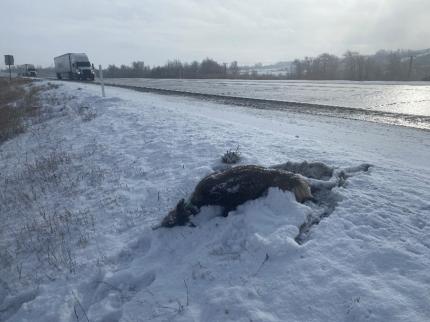
Columbia Basin Deer Surveys: District 4 Wildlife Biologist Fidorra worked with biologists across the Columbia Basin. They began to survey mule deer on the wintering grounds for a post-hunt population estimates and age to sex ratios. They will continue surveys by helicopter into December for the Odessa sub-group, while road surveys across the basin are also completed.
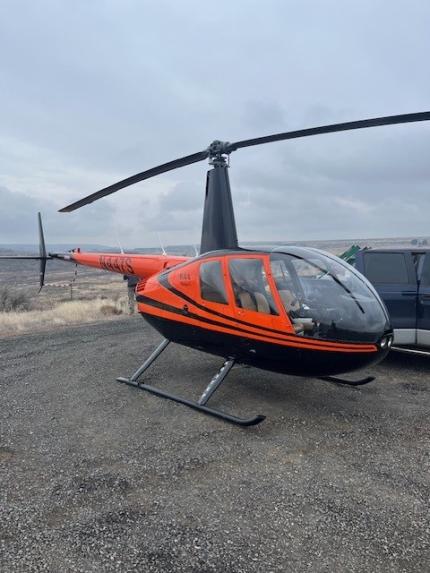
Providing Recreation Opportunities
Sunnyside-Snake River Pheasant Release: Sunnyside-Snake River Wildlife Area staff members and Natural Resource Technician Manderbach released pheasants at various sites across the Columbia Basin prior to the Thanksgiving holiday weekend.
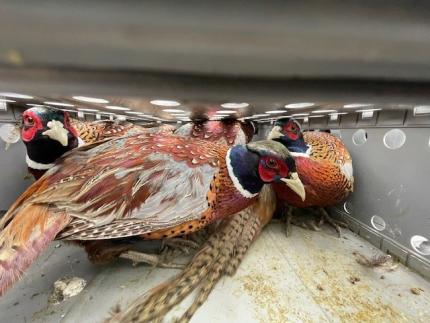
Wenas Wildlife Area Sheep Company Road Target Shooting Range Trash Clean Up: Wenas Wildlife Area Lands and Recreational Specialist Frame collected over 1,700 pounds of trash and target shooting material from Sheep Company Road target shooting area as well as the Durr Road shooting area. Items included computers, target shooting material, pumpkins, five-gallon buckets, a plastic mannequin, and plywood.
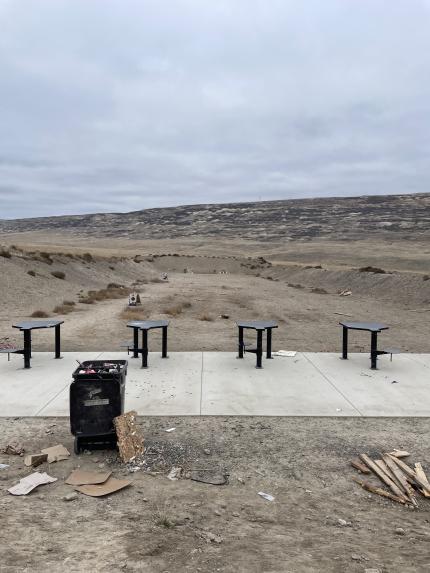
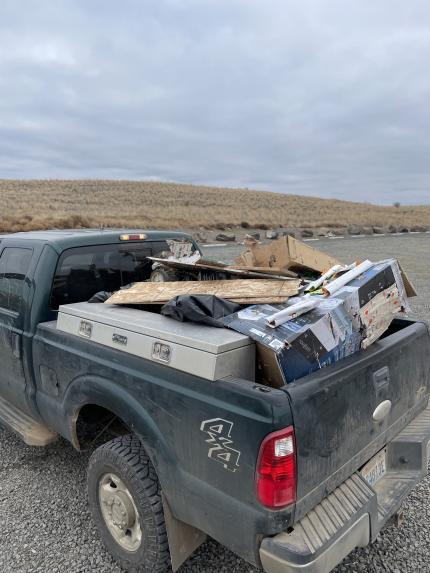
Providing Conflict Prevention and Education
Rattlesnake Hills Elk: District 4 Wildlife Conflict Specialist Hand monitored elk activity and removed trail cameras for the winter that were deployed on active historic trails leaving the Hanford National Monument.
Kittitas County Conflict: Conflict Specialist Wetzel worked with several hay growers who were having problems with elk in crops. A helicopter was used to move elk from several locations in east Kittitas County.
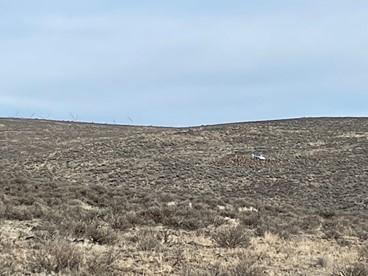
District 8 Goat Depredation: A Thorp goat producer reported several goats killed in an area where he has seen a cougar in the last few weeks. The cause of the goat deaths was undetermined.
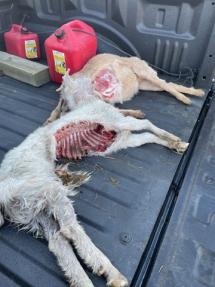
District 8 Deer Fatalities: Several deer were reported injured or killed by vehicles in the Cle Elum area. Several deer were either euthanized or retrieved from roadways and nearby residences. Conflict Specialist Wetzel euthanized a deer that had two broken rear legs due to being struck by a vehicle. He removed it after it crawled into a garage.
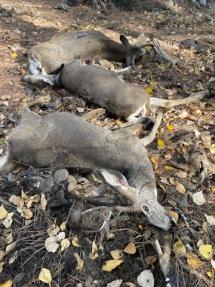
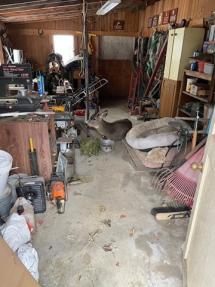
Yakima County Conflict: Conflict Specialist Wetzel worked with several hay growers who were having problems with elk in orchards. The elk have been hazed from their orchard areas.
Conserving Natural Landscapes
Bull Pasture Restoration: The Wenas Wildlife Area is restoring approximately 130 acres off Bull Pasture Road into native grass seed. This site has been chemically fallowed for two years to prep the bed prior to seeding and gain a better control of the cheatgrass and bulbous infestation. Natural Resource Technician Trahern and Assistant Manager Taylor continued harrowing and seeding the Bull Pasture area rehab.
Wenas Umtanum Creek Enhancement: Wenas Wildlife Area Manager Hughes, Assistant Manager Taylor, and Natural Resource Technician Stoltenow worked together on installing a log barb and conducted light excavation to reroute a section of Umtanum Creek that consistently flows over the county road bringing additional sediment into the creek.

Hughes received a hydraulic project approval (HPA) last winter to conduct the project. The main purpose was to correct environmental degradation and deflect the flow away from where it captures an existing county road. Habitat Biologist Bartrand was heavily involved in planning the project and overseeing the work conducted. This project will benefit the stream habitat by not taking sediment/gravel off the county road each year. It will also benefit the community who drive over the county road.
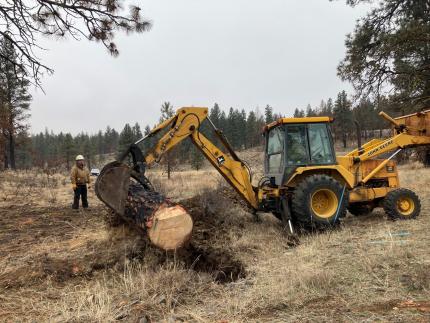
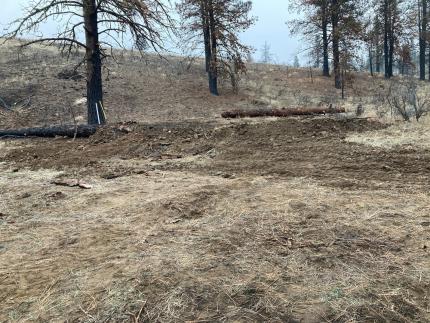
Colockum Creek Timber Restoration: Colockum Wildlife Area staff members and Washington State Department of Fish and Wildlife (WDFW) foresters have started burning slash piles left from the Colockum Creek timber restoration project. Over 100 slash piles were created from this 950-acre timber restoration. Colockum Wildlife Area Assistant Manager Hagan spent considerable time logging GPS location and pile volume information so that WDFW foresters could apply for burn permits. After permits were secured, they started lighting piles contingent on daily smoke management approval from the Washington Department of Natural Resources.
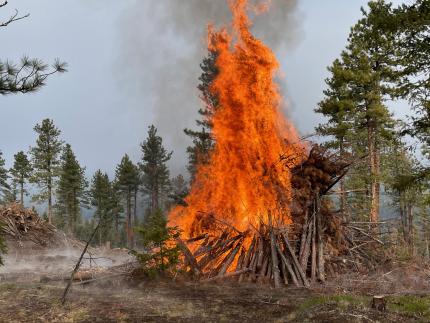
Providing Education and Outreach
Oak Creek Wildlife Area Elk Feeding Station: Oak Creek Wildlife Area staff members prepare for upcoming elk feeding tours and large numbers of visitors by posting newly updated bilingual signage. This new signage will provide important information to thousands of people that are anticipated to visit the Oak Creek feeding station during the upcoming winter.
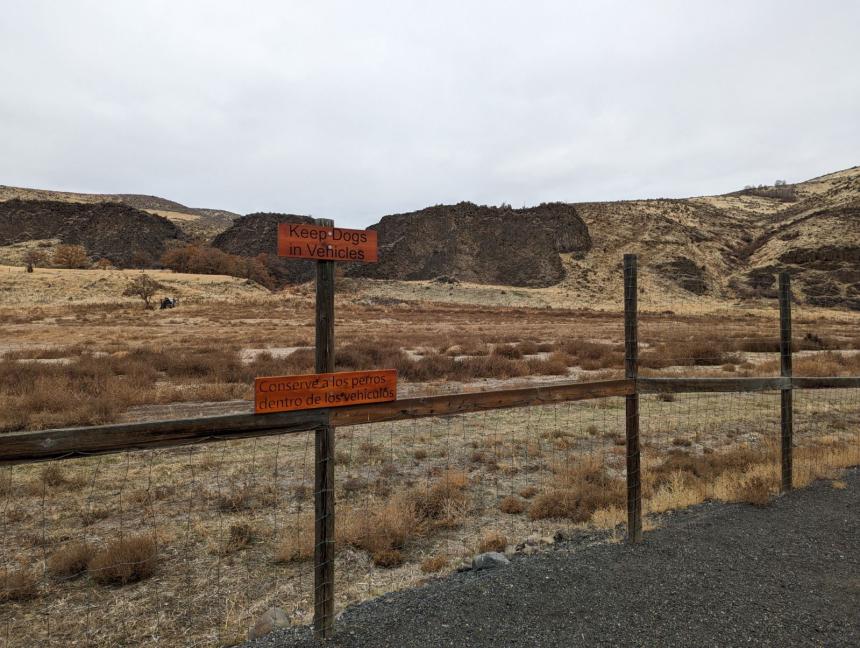
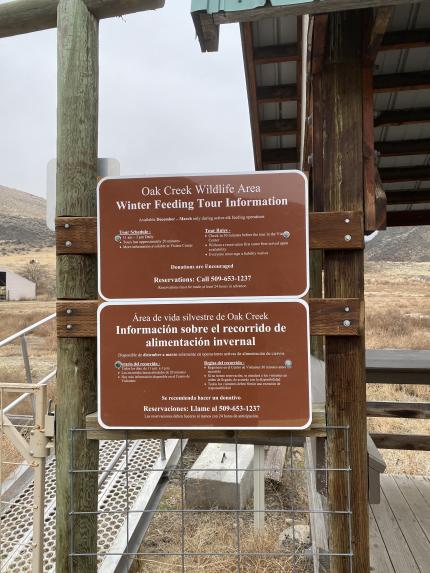
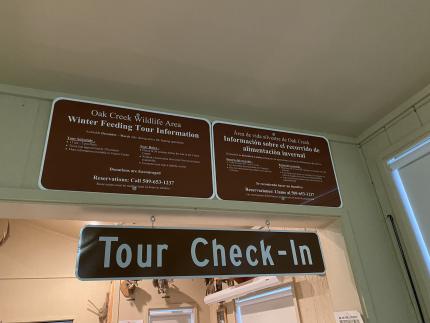
Other
Sunnyside-Snake River Wetland Maintenance: Sunnyside-Snake River Wildlife Area staff members continue to maintain waterways and wetlands throughout the wildlife area. Assistant Manager Ferguson and Natural Resource Technician Manderbach removed debris from the diversion weir box in the Johnson Wetland. Assistant Manager Jahns and Manager Kaelber also removed beaver debris in the Hope Valley Unit to alleviate flooding on neighboring private property. Routine maintenance and debris removal is required to regulate flow and maintain water levels in all waterways and wetlands throughout the fall and winter.
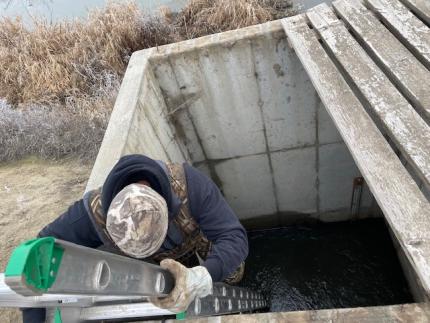
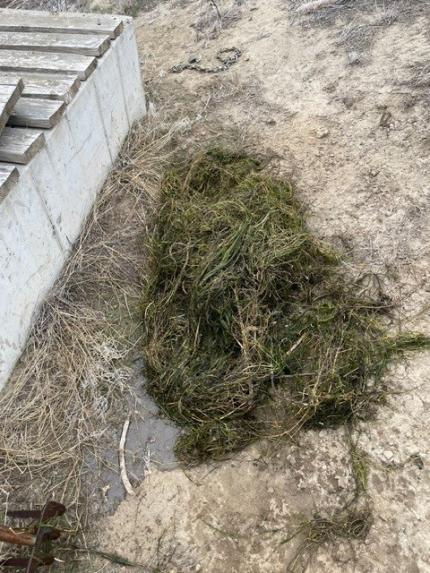
Wenas Wildlife Area Maintenance: Wenas Wildlife Area Assistant Manager Taylor and Natural Resource Technician Stoltenow added gravel to high traffic and muddy portions of the parking lot at both the main Wenas office and the Mellotte office. They used a dump truck to haul the gravel in, and they used a skidsteer/backhoe to spread and compact the gravel into place.
Managing Wildlife Populations
Ebey Slough White-nose Syndrome Monitoring Update: District 13 Biologists completed the installation of a solar powered PIT (Passive Integrated Transponder) tag reader at a maternity bat roost in Snohomish County. This equipment will help document survivorship, colony size, and colony phenology to assess efficacy of a vaccine trial to treat bats for white-nose syndrome.
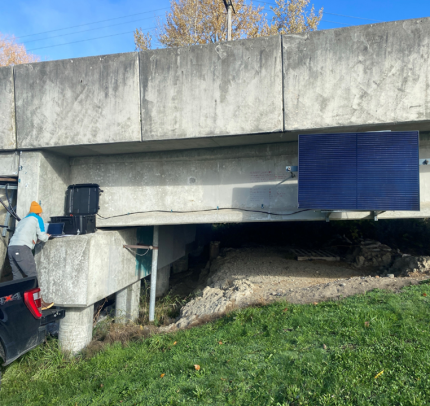
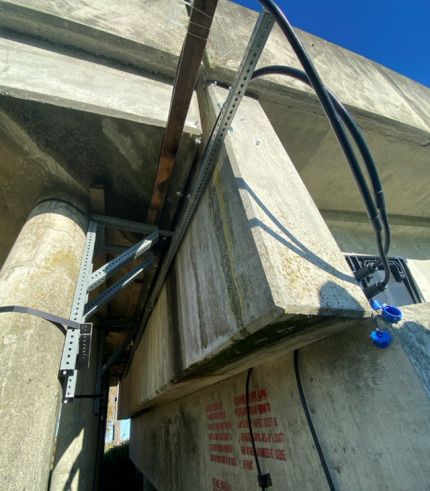
Avian Influenza Mortality Event at Lake Tye: District 13 Biologists responded to an avian mortality event at Lake Tye in Monroe, predominantly impacting cackling geese. A total of approximately 80 sick and dead cackling geese have been collected to date. Washington State Department of Wildlife (WDFW) Wildlife Program staff members collaborated with many partners including WDFW Enforcement Program, Snohomish County Parks and Recreation, WDFW Communications and Public Engagement (CAPE), and Smith-Root Inc. to collect and sample carcasses, post informational signage, conduct public outreach, and test novel methods for avian influenza detection. Biologist Licence provided multiple media interviews on the event.
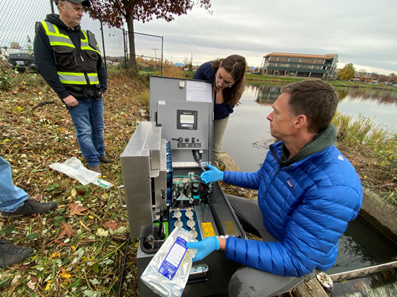
Winter Forage Ecology of Trumpeter Swans Field Project: Region 4 staff members are assisting the Waterfowl Section staff members and Graduate Student Romero in a telemetry project in the Skagit and Stillaguamish river deltas that will provide valuable insight into swan foraging, ecology, and management. Capture operations will extend into December.
Providing Recreation Opportunities
Annual Game Management Unit 485 Green River Watershed Special Permit Hunts: District 12 staff members worked the annual weeklong hunts in the Green River Watershed. A huge thanks to Tacoma Water for coordinating and hosting these special hunts. Washington Department of Fish and Wildlife (WDFW) would also like to thank the Muckleshoot Indian Nation for their annual collaboration and planning to provide for both the annual citizen and tribal special hunts in October and November each year.

Providing Education and Outreach
Burke Museum Public Coyote Necropsy: Washington Department of Fish and Wildlife (WDFW) District 12 Veterinarian Haman and members of the Prugh Lab at University of Washington conducted a training necropsy on a young, but independent, coyote that was found randomly deceased in a backyard in Seattle. The animal had been in good shape and in gross exam it appeared it had just started to decline recently – perhaps having a respiratory infection. They sent out the tests for analysis.
This was not only a great opportunity for the group of biologists to learn from Dr. Haman, but it was also an opportunity for the public to see WDFW staff members at work. Several school field trip groups dropped by the large pane window of the new, public viewing lab in the museum. It provided great outreach and it was a good opportunity for the public to see lab efforts related to wildlife biology and management. Thanks again to the Prugh Lab and Dr. Haman!
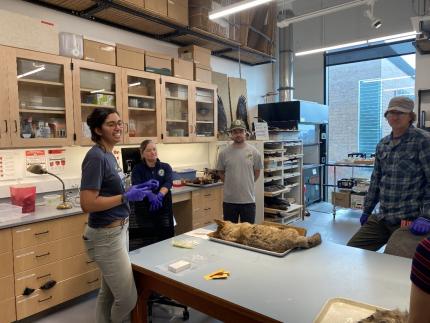
Conducting Business Operations and Policy
Park Use Conflicts with Wildlife – Seattle: Biologist Anderson met with City of Seattle staff members and a WDFW habitat biologist regarding proposed changes to the use of a Seattle park. The city plans to convert an open area that is currently staging trucks and other heavy equipment to a pickleball court. Originally, they planned for the area to be used for tennis courts. Seattle is currently weighing comments and concerns of the public and non-government agencies regarding the potential impacts to wildlife.
Bats and Bridges – Washington State Department of Transportaion (WSDOT): Biologist Anderson, WDFW Bat Specialist Tobin, and members of WSDOT Environment Group met to discuss partnerships that will provide for bats on transportation infrastructure. Many good thoughts and some pilot efforts were discussed. The hope is for the two agencies to partner on more projects in western Washington. The partnership between the agencies will support the conservation needs of bats while obtaining broader data on bat occurrence, type of use, and their overall activity patterns.
Managing Wildlife Populations
Columbian White-tailed Deer Surveys: Biologists Holman and Stephens have conducted two surveys for Columbian white-tailed deer on Puget Island. Surveys consist of driving designated routes and counting all deer and classifying them as doe, fawn, or buck. The primary purpose of the survey is to generate a doe to fawn ratio. This survey is done in partnership with the U.S. Fish and Wildlife Service, the Cowlitz Tribe, Oregon Department of Fish and Wildlife, and with support from volunteers. Survey results will be summarized in future reports. Thanks to Customer Service Specialist Kean and Regional Operations Manager Varley for participating in the surveys.
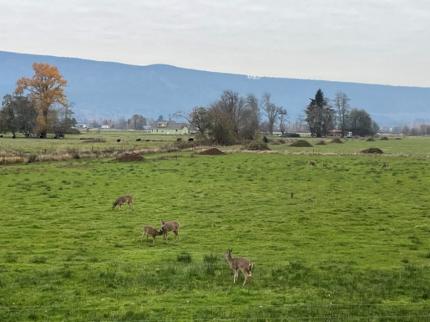
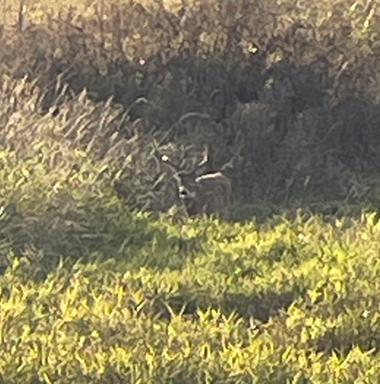
Providing Recreation Opportunities
Access Areas: Access area staff members and a Department of Corrections crew have been working together at many access areas removing debris, leaves, and fallen trees. This time of year is very busy with this type of maintenance, especially after wind and rain storms. Throughout the week, multiple areas were cleaned including Kress Lake. The Department of Corrections crew was a huge help to Washington Department of Fish and Wildlife access staff members enabling them to service multiple sites a week.
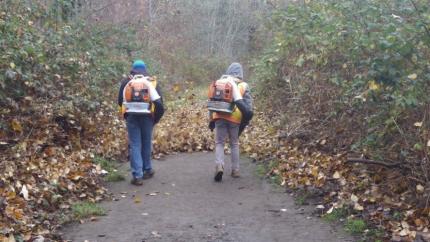
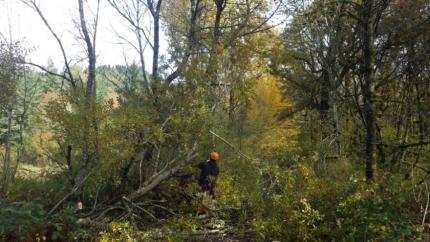
Providing Conflict Prevention and Education
District 9 Urban Coyote: Maintenance staff members from a Clark County school contacted Washington Department of Fish and Wildlife regarding a coyote with mange that had become habituated to human presence and was interacting with people and lunchboxes at the school. Wildlife Conflict Specialist Jacobsen helped the school staff members coordinate with U.S. Department of Agriculture Wildlife Services on next steps to address the issue.
Injured Deer: Wildlife Conflict Specialist Jacobsen made another attempt to capture a deer in Skamania County that has a piece of hard plastic stuck on its hoof, making the limb unusable. The deer has had this issue since mid-summer and shows up regularly at a particular residence. It changes its activity patterns every time Jacobsen tries to catch it. This time was no different.
Jacobsen did observe a beautiful black-tailed deer female with a “double throat patch” while waiting for the injured deer to show up. Jacobsen discouraged the landowner from placing out feed for the deer in the neighborhood. This issue is addressed at length in the Washington Department of Fish and Wildlife brochure “Feeding Deer in Urban and Suburban Areas…Is it Harmful?” (PDF)
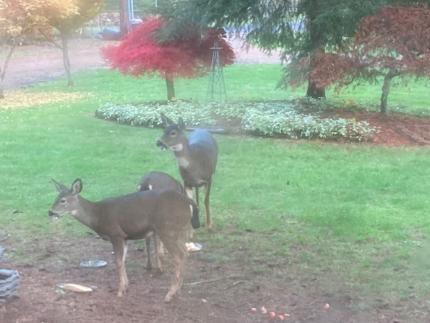
Orphaned Cougar Kittens: Wildlife Conflict Specialist Jacobsen received a call from a homeowner in Klickitat County regarding three cougar kittens that were after her chickens the previous night. Despite the fact that the homeowner had secured her three chickens in a chain-link enclosure, the kittens somehow managed to grab one of the chickens through the fence and kill it.
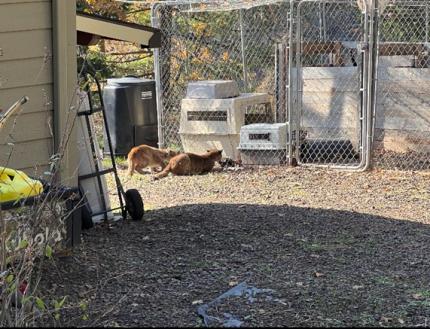
Jacobsen arrived later that morning to assess the situation and while he was knocking on the homeowner’s door to speak with them, he looked over and saw the three cougar kittens trying to get the chickens again. Based on the behavior of the kittens and the frequency with which they were visiting the residence without an adult present (verified by trail camera footage), Jacobsen determined the kittens were orphaned and would continue to cause trouble until they eventually starved to death.
Jacobsen consulted with Cougar Specialists Beausoleil and Welfelt and agreed that capturing them was the best option for the kittens. Jacobsen baited three live traps and caught two of the kittens the first night. The third kitten was captured the following night. Biologists Bergh and Wickhem and Volunteer Downing assisted in transferring the three very feisty kittens from the traps into crates for transport.
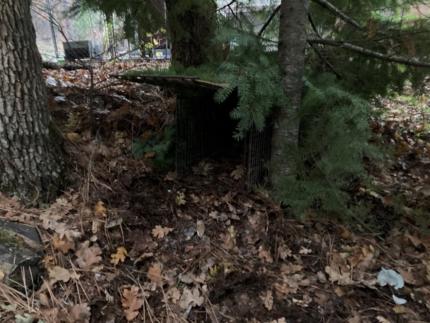
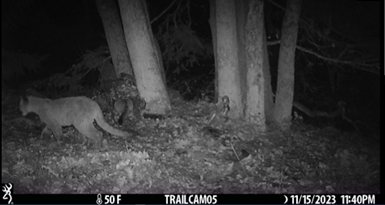
In setting the traps in the brush, Jacobsen was extensively exposed to several defoliated poison oak branches and suffered extreme itching for the next two weeks – the price of helping to rescue orphans. All three kittens were placed in Cougar Specialist Beausoleil’s care until their permanent homes in captive facilities could be determined. The kittens were approximately 17 weeks old and between 21 and 23 pounds. Orphaned cougar kittens less than one year old cannot survive in the wild without their mother and cannot be rehabilitated and taught to catch natural prey by humans. Therefore, the only alternative to starvation in the wild is placement in an accredited facility (usually a zoo) capable of caring for cougars. All three kittens will soon be headed to the east coast for final placement in the coming week.
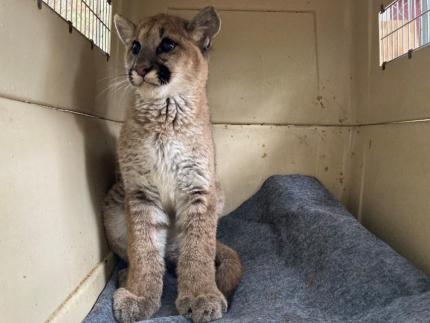
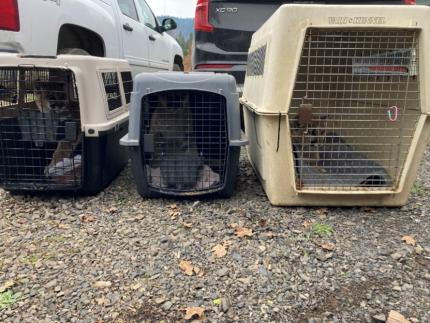
Damage Prevention Cooperative Agreements: Wildlife Conflict Specialist Jacobsen met with several crop producers in Klickitat County to renew their annual Damage Prevention Cooperative Agreements.
Livestock Carcass Sanitation: Wildlife Conflict Specialist Jacobsen collected and hauled deceased livestock carcasses away from a livestock operation in Klickitat County to help prevent the Big Muddy wolf pack from scavenging on carcasses in the area.
Conserving Natural Landscapes
Klickitat Wildlife Area Forest Health Enhancement Project Phase II: Operations on the Forest Health Enhancement Project began this month. This project involves thinning timber on the Soda Springs Unit. The objective is to improve forest health by thinning the stand, thereby reducing competition among trees for scarce water resources, improve forest resistance to wildfire by removing some of the fuel, and leave a more open understory that is less conducive to fire spread, and do this while maintaining quality habitat for the western gray squirrel.
The western gray squirrel was recently uplisted to endangered status in Washington State. They depend on a forested environment. By promoting forest health and resistance to wildfire, we will help western gray squirrels persist on the wildlife area. The current project is to thin between 247 and 270 acres of western gray squirrel occupied forest. As of 2021, there were 797 western gray squirrel nests within the project area. The whole area was resurveyed for nest trees in 2023 prior to the implementation of the project. At that time, adjustments were made to protect the nest trees.
Washington Department of Fish and Wildlife completed a similar project in 2018 (Phase I) on the Klickitat Wildlife Area. They found that two years after the forest thinning was done there was no significant change in the number of western gray squirrel nests within the project area compared to the number of nests prior to harvest. This project demonstrates that a carefully planned and implemented forest management project can be undertaken within a western gray squirrel occupied forest while conserving the important habitat features that the squirrels require.
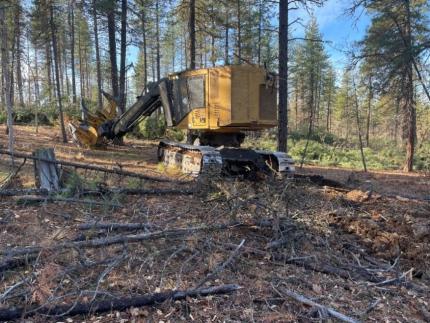
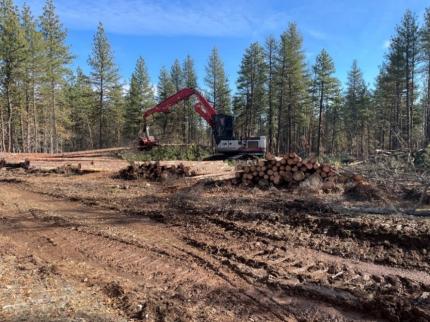
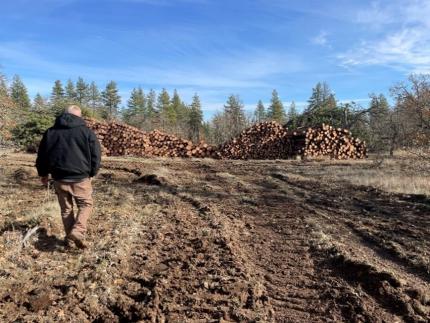
Simcoe Unit Fence Inspection: Wildlife Area Manager Van Leuven was aware of unauthorized fence construction on the Simcoe Mountains Unit as well as damage to newly constructed property boundary fences. VanLeuven visited the property to investigate the extent of the damage. Unfortunately, the fence was cut in seven places. VanLeuven recorded the coordinates and mapped all of the damage. The photo below shows an example of the condition of the fence. Manager VanLeuven spoke with a neighbor of the Simcoe Unit, who explained that he had cut the fences and why. A meeting has been scheduled to resolve the issue.
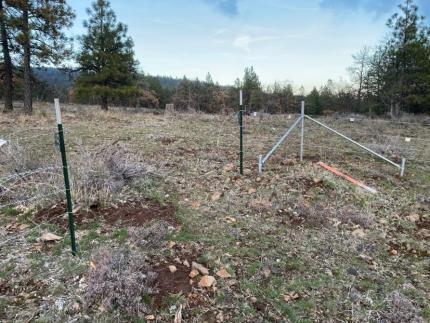
Another incident occurred during the inspection of the fence, where VanLeuven discovered two men cutting firewood without a permit on the Washington Department of Fish and Wildlife (WDFW) property along a road beyond a sign informing visitors, “No Unauthorized Vehicles Beyond This Point”. VanLeuven contacted them and later forwarded information to WDFW officers for possible follow-up. While on the Simcoe Unit, VanLeuven added reflective tape to the three new panel gates to make them visible at night, to avert damage from vehicle collisions.
Providing Education and Outreach
Bat Outreach Presentation: Biologist Stephens gave a presentation about bats to a group of Lewis County residents. The presentation was organized by the Lewis County Stream Team and the focus was bat biology, white-nosed syndrome, Washington Department of Fish and Wildlife bat research, and creating backyard bat habitat. The presentation was well-attended, the group was very interested in bats, and they asked many great questions.
Vancouver Wildlife League Presentation: Biologist Holman presented on southwest Washington black-tailed deer research and management to a group of approximately 25 members of the Vancouver Wildlife League. The presentation featured summaries of WDFW research on doe/fawn ecology related to forest management, buck survival, current methods for monitoring black-tails, and future strategies for black-tail monitoring. Thanks to Ungulate Specialist Oates for providing much of the presentation material. Thanks to the Vancouver Wildlife League for their involvement in hunting and fishing related activities and advocacy spanning nearly 100 years in southwest Washington.
Providing Recreation Opportunities
Kitsap Lake, Kitsap County: The water access team removed a hazard tree at Kitsap Lake. This tree was broken roughly 30 feet up and was leaning over the back of the restroom towards the parking area. The access team was able to attach a cable to a truck and shake the lower portion of the tree subsequently forcing the upper part to fall in a controlled manner.
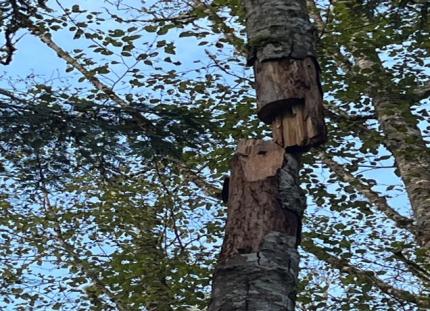
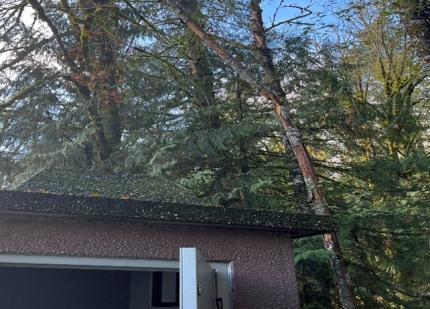
Morely Access, Grays Harbor: Access staff members dealt with a slew of littering issues including dumping of tires, construction debris, and abandoned vehicles. Shown below is a full trailer of 46 car and semi-truck tires dumped at the Morely Access Area on the Humptulips River. The cost for recycling commercial size tires is significantly more than passenger vehicle tires. This one trailer load cost over $350 to recycle.
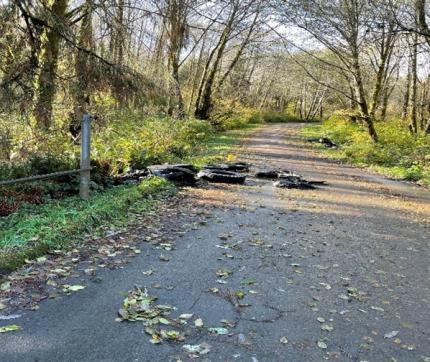
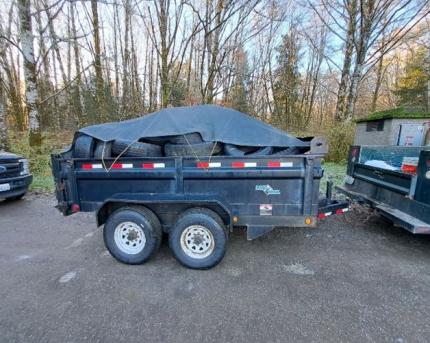
Boston Harbor, Thurston County: Access staff members removed a dead madrone tree at the Boston Harbor ramp project. The project is nearing completion and includes a new boat ramp, restrooms, and parking area. Access staff members limbed and chipped most of the debris into the nearby planting strip. They left a ten-foot section that will remain as a post for the bat boxes that will be installed later this year.
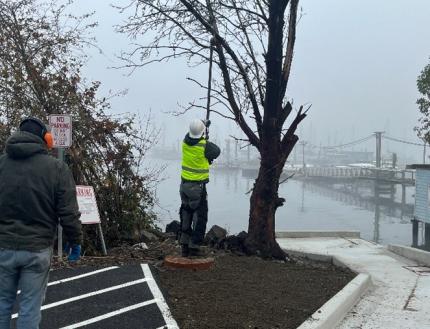
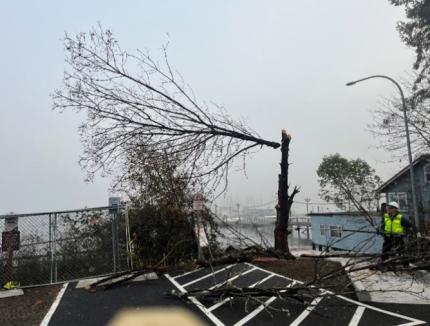
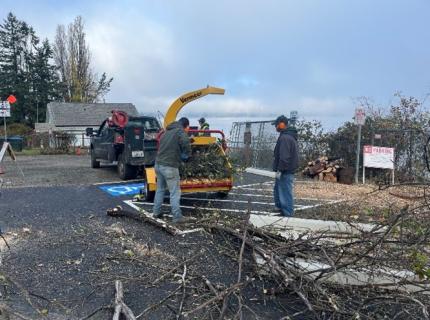
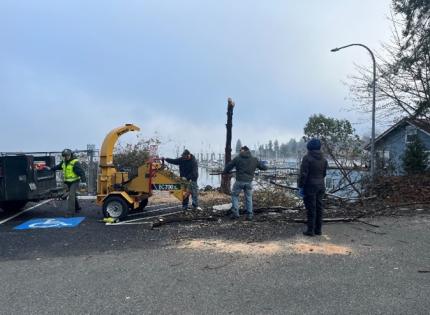
Conducting Business Operations and Policy
McNeil Island Site Visit: Biologist Laushman, Wildlife Program staff members, and Lands Division staff members visited restoration areas on McNeil Island to look at previous work done and to discuss upcoming projects.
